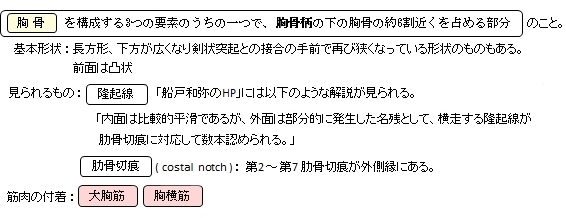胸骨体とは


「船戸和弥のホームページ」では以下のように解説している。
「胸骨柄の下端は胸骨体と結合する。この結合部はかなり長期間軟骨性の結合のままで経過し、ここが骨性の結合となるのは成年以後に成ってからである。したがって若い個体の晒した骨では胸骨柄と胸骨体が分離してしまっている。胸骨体は胸骨柄の約3倍の長さの長方形の部分で、その幅は下方にいくにしたがって徐々に広くなるが、下端では急に狭まっている。その前面は後面に比べればやや凸面に近い。側面は肋軟骨と関節するための6対の切痕がある。 」
また、以下は「Wikipedia」の解説文となる。
「The body, or gladiolus, is the longest part. It is flat and considered to have only a front and back surface. It is flat on the front, directed upward and forward, and marked by three transverse ridges which cross the bone opposite the third, fourth, and fifth articular depressions. The pectoralis major attaches to it on either side. At the junction of the third and fourth parts of the body, is occasionally see an orifice, the sternal foramen, of varying size and form. The posterior surface, slightly concave, is also marked by three transverse lines, less distinct, however, than those in front; from its lower part, on either side, the transversus thoracis takes origin.
The sternal angle is located at the point where the body joins the manubrium. The sternal angle can be felt at the point where the sternum projects farthest forward. However, in some people the sternal angle is concave or rounded. During physical examinations, the sternal angle is a useful landmark because the second rib attaches here.[1]
Each outer border, at its superior angle, has a small facet, which with a similar facet on the manubrium, forms a cavity for the cartilage of the second rib; below this are four angular depressions which receive the cartilages of the third, fourth, fifth, and sixth ribs. The inferior angle has a small facet, which, with a corresponding one on the xiphoid process, forms a notch for the cartilage of the seventh rib. These articular depressions are separated by a series of curved interarticular intervals, which diminish in length from above downward, and correspond to the intercostal spaces. Most of the cartilages belonging to the true ribs, articulate with the sternum at the lines of junction of its primitive component segments. This is well seen in some other vertebrates, where the parts of the bone remain separated for longer.[citation needed]
The upper border is oval and articulates with the manubrium, at the sternal angle. The lower border is narrow, and articulates with the xiphoid process.」
【参考になるサイト】
・イラストや写真を掲載しているサイト-Ⅰ
・イラストや写真を掲載しているサイト-Ⅱ
・イラストや写真を掲載しているサイト-Ⅲ
・イラストや写真を掲載しているサイト-Ⅳ
・イラストや写真を掲載しているサイト-Ⅴ

|